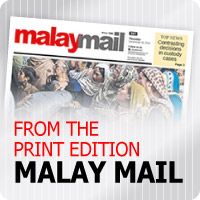 KUALA LUMPUR, July 13 — The seven underground stations in phase two of the Mass Rapid Transit (MRT) Sungai Buloh-Kajang (SBK) line, to be opened on Monday, are unique as they are decorated with fine works of art.
KUALA LUMPUR, July 13 — The seven underground stations in phase two of the Mass Rapid Transit (MRT) Sungai Buloh-Kajang (SBK) line, to be opened on Monday, are unique as they are decorated with fine works of art.
The seven underground stations are considered to be MRT’s “masterpiece” since they are designed to inspire commuters with their artwork and architectural design. The second phase consists of 19 stations.
MRT Strategic Communication and Stakeholder Relations director Datuk Najmuddin Abdullah said commuters would enjoy the beauty of the seven underground stations as they have different designs resembling the meaningful life of Malaysians.
Starting at the Muzium Negara station, the passengers will be able to walk down memory lane on the evolution of public transport in the country from bus, taxi to train services, besides reminiscing the nostalgic moments of using the transport.
“The seven stations have their own elements. At Muzium Negara station, which is next to KL Sentral, you can see that on every pillar, there are photos of taxi, bus and train services from past generations until the present,” he told Bernama.
The Pasar Seni station is all about culture, arts and craft, signifying the role of the arts centre in promoting the country’s cultural heritage.
The passengers would experience a wonderful blue visual treat and appreciation of Malaysia’s heritage and architecture at a glance when they step into the station that is linked to the Kelana Jaya LRT line.
The Merdeka Station, located near the historic Merdeka Stadium, signifies the aspect of patriotic elements.
On display is a mural portraying a silhouette of the “Father of Independence,” the late Tunku Abdul Rahman, the country’s first prime minister, raising his hand during the declaration of independence on Aug 31, 1957.
“The wall is going to be very popular among commuters once the station is open. I am sure it is going to be a hit. Every Malaysian will go there and they will spend time taking selfies and wefies at that wall,” said Najmuddin.

Another “must visit” place is the Bukit Bintang station, where the artistic value of the station resembles the “dynamic and excitement” elements of the country’s top central business district.
The station’s wall was designed on a bright red colour artwork to reflect its dynamism, apart from the station providing easy access to one of the busiest areas in this capital.
“Before this, it was quite a nightmare entering Bukit Bintang from every direction but now, MRT is in the middle of it,” said Najmuddin.
At the Tun Razak Exchange station, the station’s identity is a resemblance of the “Islamic Corporate”.
The station reflects the contemporary, formal and corporate atmosphere of the country’s prominent role in promoting the Islamic corporate world.
The last two of its underground stations, Cochrane and Maluri, represent the elements of “urban living and new generation”.

These stations were designed to portray contemporary art with vibrant, urban, and youthful elements.
Asked about the safety elements of these underground stations, Najmuddin said they are “best-in-class” and state-of-the-art technology.
He said the safety systems were put in place to ensure that emergencies were quickly and efficiently managed when the need arose.
All the underground stations are equipped with automatic fire and sprinkler systems and public address systems for passenger paging and mass evacuation.
“The SBK Line underground stations are also incorporated with green technology to boost energy efficiency,” he said.
“The features that cater to the physically challenged include ticket gates wide enough to accommodate wheelchairs, movement-triggered elevators from the ground level to the concourse and platforms, braille markings on lift control buttons, and step-free access drop off points.”
Commuters need not worry as each station would be staffed with sufficient attendants, security control system, monitored by closed-circuit television (CCTV) cameras, and help phones. All materials used in the underground stations and trains are non-flammable.
The first phase covering 21km from Sungai Buloh to Semantan and consisting of 12 stations became fully operational last December.
The RM23 billion SBK line from Sungai Buloh to Kajang (51km) will serve as a corridor to a population of 1.2 million people, linking their homes with their destinations in the city.
Each train set serving the SBK line will have four cars, allowing a total capacity of 1,200 passengers per trip with daily ridership of about 400,000 passengers. The trains will run at a frequency of 3.5 minutes.



















